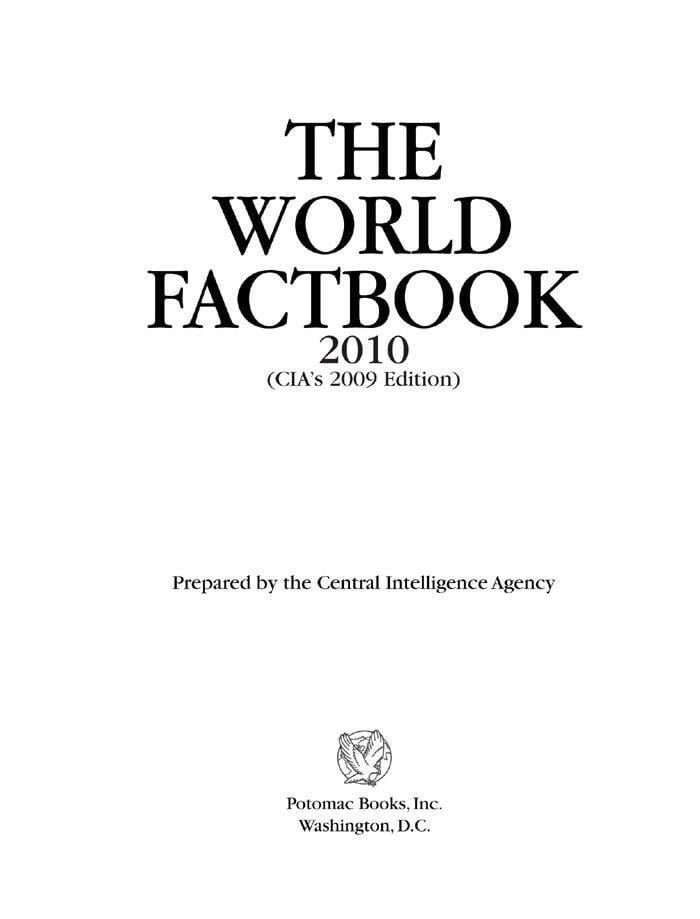Originally published 1962 | ||
 | ||
Author Publisher Directorate of Intelligence Publication date See frequency of updates and availability, no longer published in paper book form by the CIA Similar World Book Encyclopedia, Encyclopædia Britannica, Columbia Encyclopedia, Der Fischer Weltalmanach | ||
The World Factbook (ISSN 1553-8133; also known as the CIA World Factbook) is a reference resource produced by the Central Intelligence Agency with almanac-style information about the countries of the world. The official print version is available from the National Technical Information Service and the Government Printing Office. Other companies—such as Skyhorse Publishing—also print a paper edition. The Factbook is available in the form of a website that is partially updated every week. It is also available for download for use off-line. It provides a two- to three-page summary of the demographics, geography, communications, government, economy, and military of each of 267 international entities including U.S.-recognized countries, dependencies, and other areas in the world.
Contents
- Copyright
- Frequency of updates and availability
- Government edition of the Factbook
- Reprints and older editions online
- Entities listed
- Political
- Factual
- References
The World Factbook is prepared by the CIA for the use of U.S. Government officials, and its style, format, coverage, and content are primarily designed to meet their requirements. However, it is frequently used as a resource for academic research papers and news articles. As a work of the U.S. Government, it is in the public domain in the United States.
Copyright
Because the Factbook is in the public domain, people are free under United States law to redistribute it or parts of it in any way that they like, without permission of the CIA. However, the CIA requests that it be cited when the Factbook is used. Copying the official seal of the CIA without permission is prohibited by U.S. federal law—specifically, the Central Intelligence Agency Act of 1949 (50 U.S.C. § 403m).
Frequency of updates and availability
Before November 2001 The World Factbook website was updated yearly; from 2004 to 2010 it was updated every two weeks; since 2010 it has been updated weekly. Generally, information currently available as of January 1 of the current year is used in preparing the Factbook.
Government edition of the Factbook
The first, classified, edition of Factbook was published in August 1962, and the first unclassified version in June 1971. The World Factbook was first available to the public in print in 1975. In 2008 the CIA discontinued printing the Factbook themselves, instead turning printing responsibilities over to the Government Printing Office. This happened due to a CIA decision to "focus Factbook resources" on the online edition. The Factbook has been on the World Wide Web since October 1994. The web version gets an average of 6 million visits per month; it can also be downloaded. The official printed version is sold by the Government Printing Office and National Technical Information Service. In past years, the Factbook was available on CD-ROM, microfiche, magnetic tape, and floppy disk.
Reprints and older editions online
Many Internet sites use information and images from the CIA World Factbook. Several publishers, including Grand River Books, Potomac Books (formerly known as Brassey's Inc.), and Skyhorse Publishing have re-published the Factbook in recent years.
Entities listed
As of July 2011, The World Factbook consists of 267 entities. These entities can be divided into categories. They are:
Political
Factual
The Factbook is full of usually minor errors, inaccuracies, and out-of-date information, which are often repeated elsewhere due to the Factbook's widespread use as a reference. For example, Albania was until recently, described in the Factbook as 70% Muslim, 20% Eastern Orthodox, and 10% Roman Catholic, which was based on a survey conducted in 1939, before World War II; numerous surveys conducted since the fall of the Communist regime since 1990 have given quite different figures. Another example is Singapore, which the Factbook states has a total fertility rate of 0.78 children per woman, despite figures in Statistics Singapore which state that the rate has been about 1.2–1.3 children per woman for at least the past several years, and it is unclear when, or even whether, it ever dropped as low as 0.78. This low and inaccurate value then gets cited in news articles which state that Singapore has the world's lowest fertility, or at least use the figure for its shock value. Another serious problem is that the Factbook never cites its sources, making verification of the information it presents difficult if not impossible.
In June 2009, National Public Radio (NPR), relying on information obtained from the CIA World Factbook, put the number of Israeli Jews living in settlements in the West Bank and Israeli-annexed East Jerusalem at 250,000. However, a better estimate, based on State Department and Israeli sources put the figure at about 500,000. NPR then issued a correction. Chuck Holmes, foreign editor for NPR Digital, said, "I'm surprised and displeased, and it makes me wonder what other information is out-of-date or incorrect in the CIA World Factbook."
Scholars have acknowledged that some entries in the Factbook are out of date.
